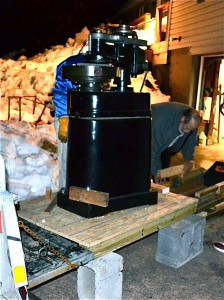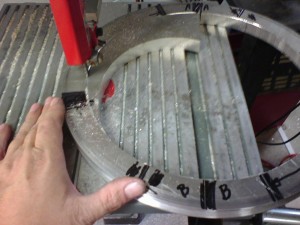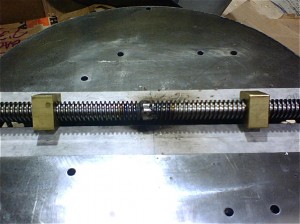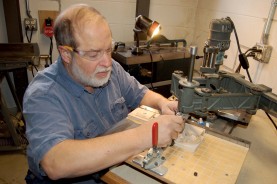A Block Leveler for MWT
One of the advantages I have had in cutting wood type is that I can produce 12” x 12” blocks of end grain hard maple that is type high and in large batches. I designed and build a steel framed, very heavy duty accurate surface sander as one of my first machines. Even with my machine and 40 years of woodworking experience, I still had to send each slab through sander over 450 passes, while changing velcro backed abrasive strips from 80 grit to 600 grit to get the 1 1/8” maple down to .918”. Lots of time and hard on my wrist.
I have studied the type high machine at the Hamilton Wood Type Museum in Two Rivers, Wisconsin, with it’s 16 inch horizontally mounted carbide saw blade and belt driven 20 foot screw drive gear. Way too big and way too expensive to reproduce.
When I was discussing my process at the APA Wayzgoose at Mt. Pleasant, Iowa in June, I was informed that the best machine I could use to cut away the unwanted thickness from the back of the polished maple fronts was called a “Block Leveler.” I had seen pictures of a large Vandercook Block leveler on Nick Sherman’s site that is in a collection in New Jersey.
I had decided to build one of my own design from a large Hammond Radial Router that I purchased from Don Black Linecasting in Toronto. I made the trip to Canada and brought it home in the back of my little Honda CRV and started designing my own block leveler.
In June I was offered the chance to purchase a real Hacker Block Leveler that was manufactured by Vandercook in 1923. I made the trip to the mountains of West Virginia with my daughter and hauled it home in a rented trailer with brakes smoking as we came down the mountain in 9 degree slopes. The actual visit to Rich’s famous type casting shop will be covered in the near future.
I have been cleaning the block leveler and adding two new motors. One to run the cutter head that originally was 3 phase, and now will be single phase. The second motor is part of a pulley and belt system to slowly rotate the turntable that holds the wood. Access to a big metal lathe to turn the 14 inch table pulley ring and other new parts has been a big help. I also found the original Hacker Patent drawings on the web to help build the self-centering wood vice I was reverse engineering. I am going to try it out this weekend. Yea!






